Moose IDE is a group of tools connected the one with the others that one can use to explore a model. On this page, we group the documentation for each tool.
Moose Toolbar
The Moose toolbar is a group of entries in the main Pharo toolbar that provides fast access to all the Moose IDE tools.
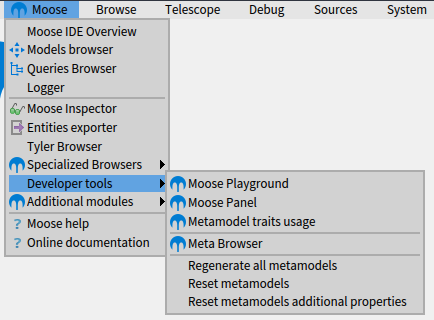
The toolbar is divided into three categories.
- The main tools
- Specialized tools to perform more advanced query and model exploration
- Documentation
Moose IDE Overview
The Moose IDE Overview is the entry point to perform analysis with Moose. It presents the current Browsers and Buses in the Moose environment.
This browser offers two main features: opening a new browser and creating a new bus.
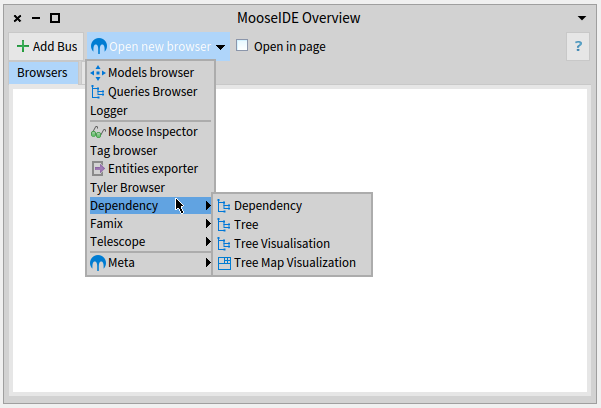
Opening Browser
To open a browser, select in the menu the browser you want to open.
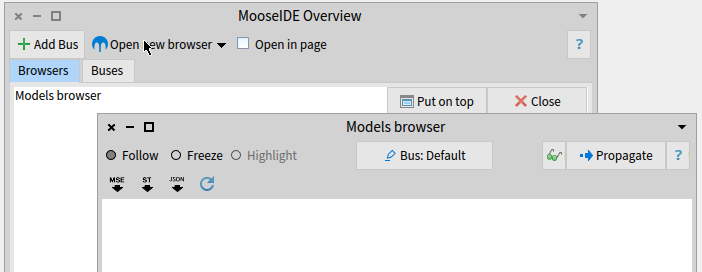
The browser opens itself in the Moose environment. Then, you can see an entry in the Moose IDE Overview browser corresponding to this browser. You can use this entry to close the browser, or to put in on top of the others browser. This is a nice feature when you have several browsers opened and need to find a specific one.
By checking the Open in page checkbox, the browser opens itself inside the Moose IDE Overview browser.
It alows you to keep at the same place every browser you want.
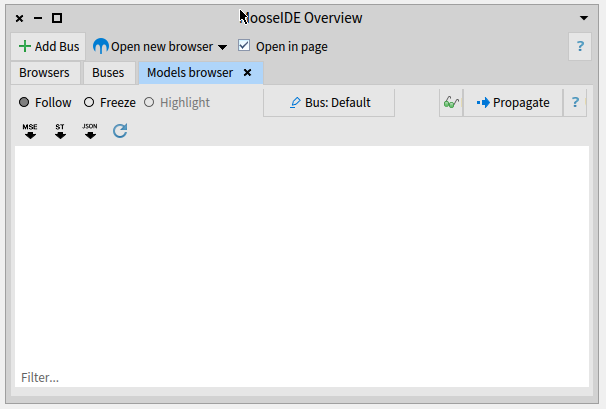
Creating a new bus
Need more documentation here? open an issue
Models Browser
The Models Browser allows one to load a model in the Moose environment.

They are three ways to load a model:
- With the mse button: load a model store in a MSE file
- With the json button: load a model store in a JSON file
- With the st button: create a Smalltalk model based on the code of the current Moose image
When importing a model from a file (JSON or MSE), a popup appears. You have to select the kind of model that will be populated. It is important to select the model that has the correct metamodel. For instance, to analyze a Java Project, you have to select FamixJavaModel.
Queries Browser
The “Queries Browser” is one of the most powerful tools of Moose. It allows one to perform advanced queries on any model based on the meta-model.
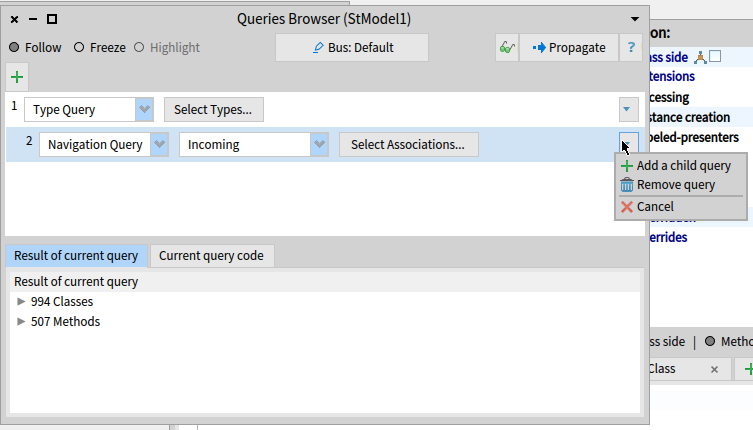
There are two panes: the one at the top of the window contains the query performed on the previous result (or the root element), the panel at the bottom presents the result grouped by element type.
To create a new query on the root element, one can click on the green ”+”, and to create a query on the previous query, one can click on the right-hand arrow and press Add a child query.
Logger Browser
The logger browser keeps a trace of everything you explore (i.e. that goes into a bus).
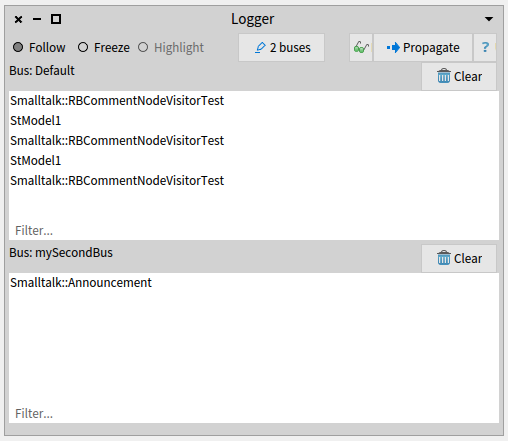
You can visualize multiple buses, after selecting an element, propagating it again, and clear the logger if too many items are present.
Moose Inspector
Moose Inspector is an advanced and convenient tool to explore a model or any moose entity.
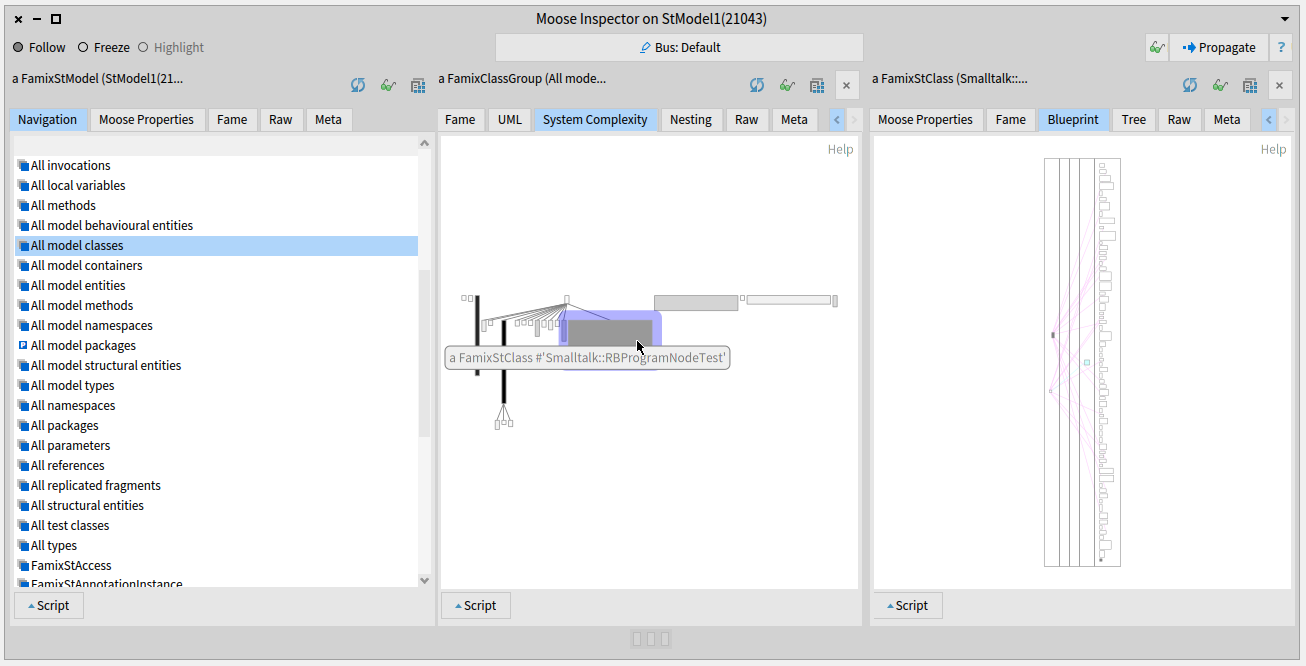
The moose inspector is divided into several horizontal panels. Each panel is composed of several tabs. Standard tabs are Navigation, Moose Properties, Fame.
When inspecting an element, a panel inside the moose inspector is opened. By default, the Navigation tab is also opened. It allows you to see the other concept linked to the one currently inspected. For example: when inspecting a Java class, it shows the subclasses, the superclass, and the methods and the attributes of the class. By selecting an element, a second panel will open next to the original one inspecting the selected elements.
When inspecting specific kind of entity, new tab might appears. They offer to the end-user new way to visualize their data. For instance, when inspecting a group of classes, on can see it as a UML schema, a system complexity, or with a nesting view. Or, when inspecting a class, one can see its corresponding blueprint.
It is also possible to perform advanced queries from the Moose Inspector. To do so, by clicking on the script button, one can write any piece of code they want to executed on the inpected entity.
Be careful; when performing customized scripts, you can leave the Moose Environment. You may want to learn more Pharo before performing such a complex script
Tree browsers
There are three browsers that allows you to visualize and explore a model and its entity as a tree. All these browsers can be found under the Dependency menu entry.
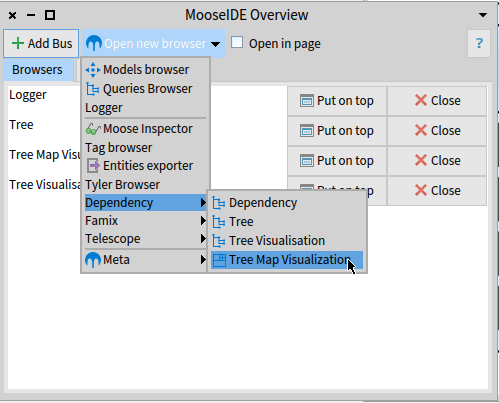
Tree Browser
The Tree Browser presents an entity and allows one to explore the contained entities. For instance, one can see the methods of a class, and the local attribute of a method.
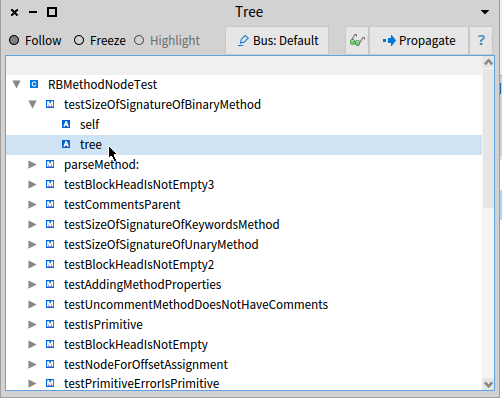
Tree visualization browser
When a group of entity is explored, the Tree Visualization Browser presents them as a tree.

In the example, we performed a query that gives us a group of classes and methods. By propagating the result to the Tree Visualization Browser, we got a visualization telling us that these methods are defined in the class.
Tree Map Browser
The Tree Map Browser is a visual way to explore the contained entities.
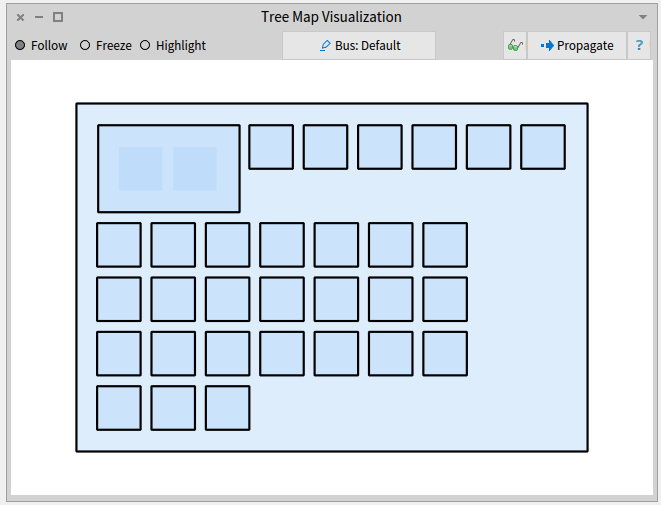
In the example, we are exploring the RBMethodNodeTest class (as for the Tree Browser example).
The main box represents the class, the box inside it the methods of the classes, and inside the methods are the local variables.
One can click on each box to open or close the box and explore the contained entities.
Famix Browsers
Some browsers are super helpful when exploring an application model (e.g. a model of a Java application). We named this collection of browsers: the Famix Browsers.
UML Browser
The UML Browser presents the UML diagram of the selected classes.
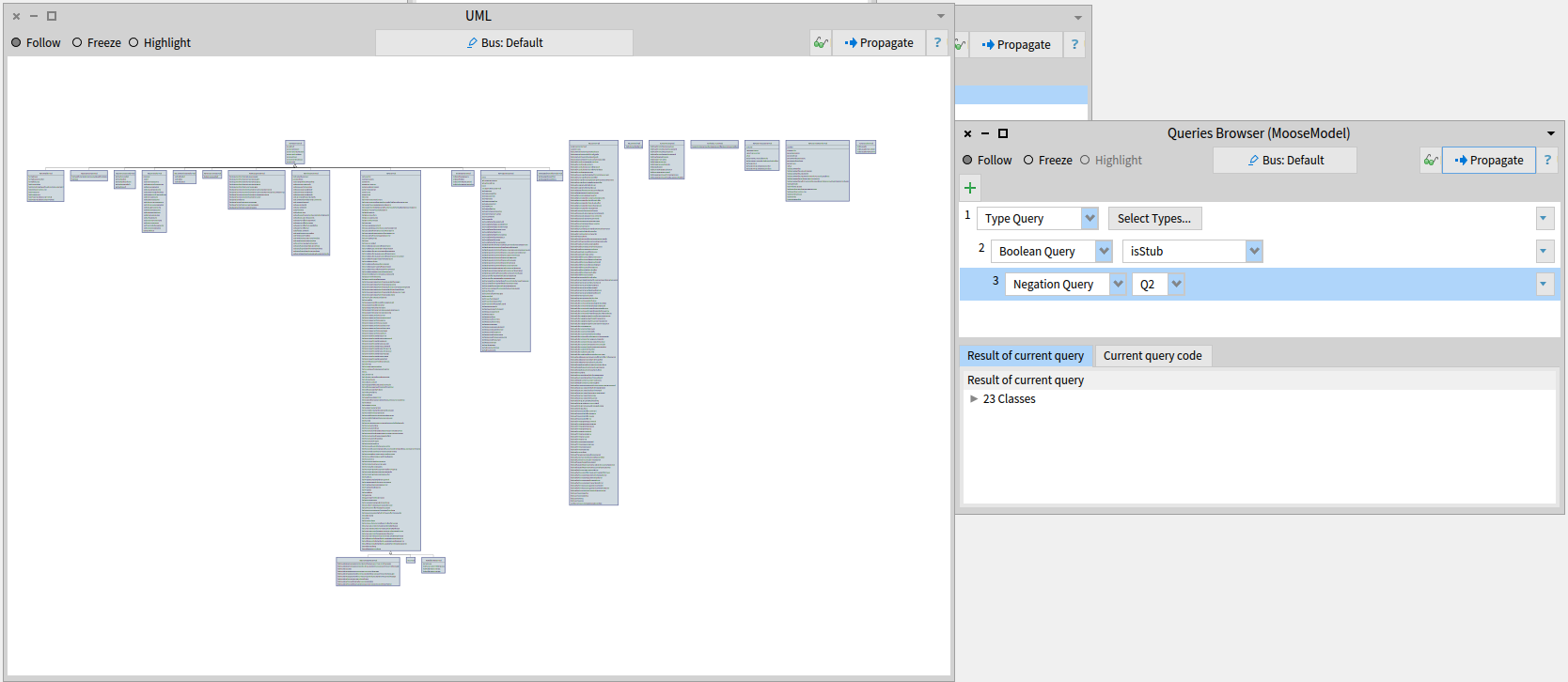
In the example, we query the classes that are not a stub. The UML Browser presents us the UML of the application.
Source code Browser
The Source code Browser shows the source code of a selected entity if available. For instance, when clicking on a class of the preceding example, we get its source code in the Source code Browser.
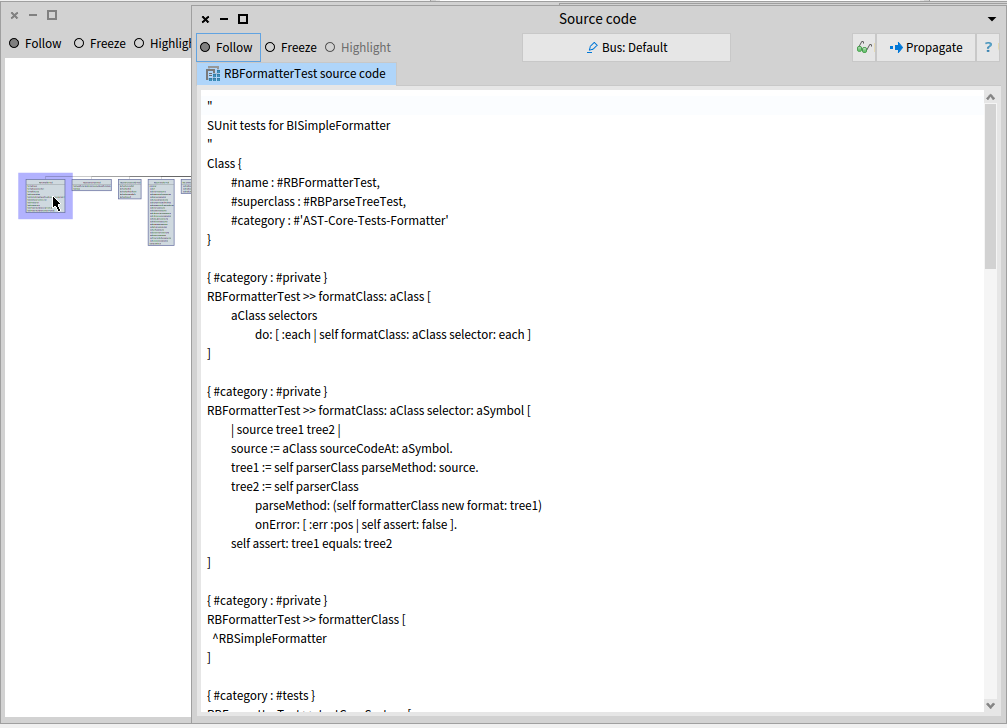
In the example, it shows up the source code of the RBFormatterTest class.
Files Browser
The files browser allows one to explore the model based on the existing files hierarchy. It is divided into two panes. The right-hand pane shows a file browser where the user can navigate. The left-hand pane shows the entities in the model that are present at this level in the file hierarchy (i.e. the classes, methods, and attributes defined in the selected directory).
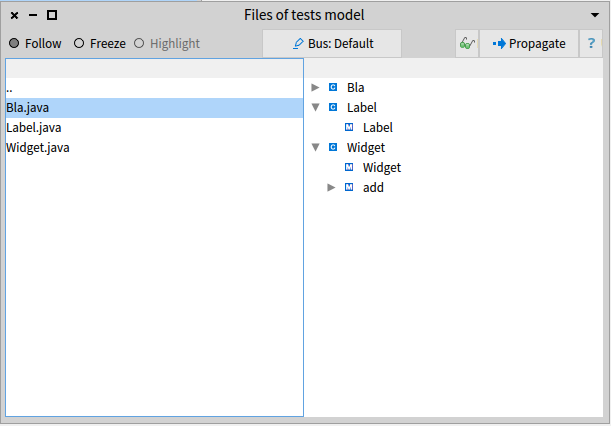
In the example, we retrieve the three classes in the selected folder: Bla, Label, and Widget.
And the user is exploring the Label and the Widget classes.
Meta Browsers
Meta browsers are browsers that present general information on an entity or a model.
Moose Model Browser
The Moose model Browser presents all model entities grouped by entity type. It is an excellent browser to select several entities of the same type.
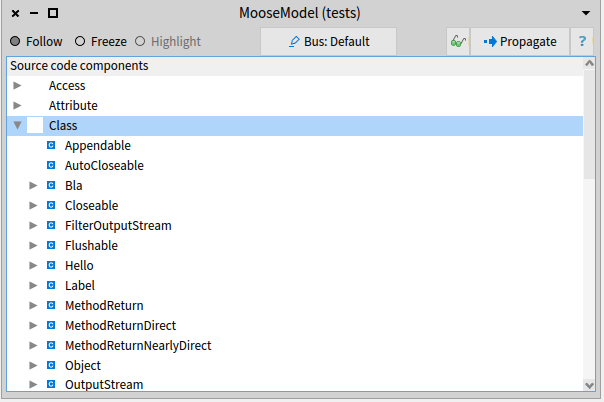
In the above example, the user explores the classes of the model.
Properties Browser
The Properties Browser presents the list of properties of any Moose element.
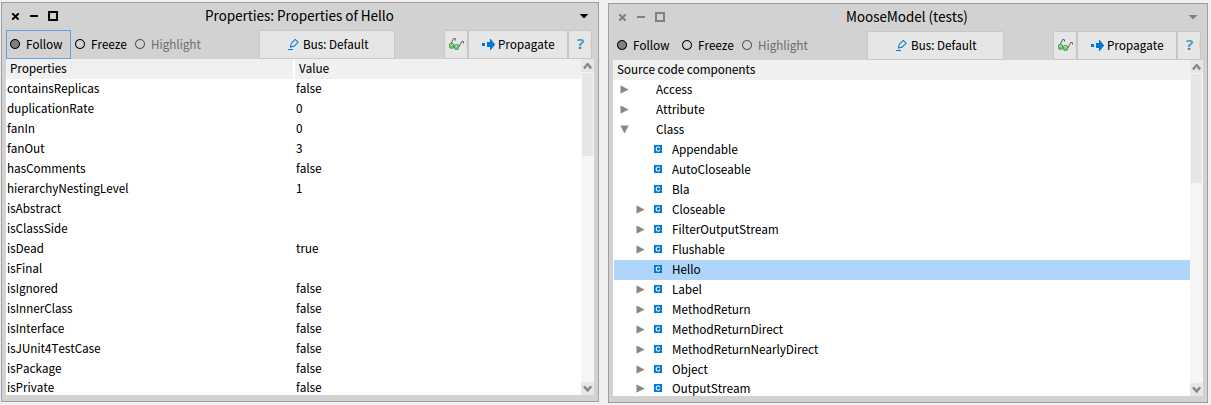
For example, it can present the number of lines of code of a class, the number of methods, etc.
Fame Browser
The Fame Browser is a metamodel developer tool that shows the existing meta properties of an explored element.

For instance, it allows one to retrieve the navigation properties, the basic properties, and their characteristics (i.e., type, derived?, source/target navigation, etc.).
Meta Browser
The Meta Browser helps one to get an overview of the meta-model of any element.
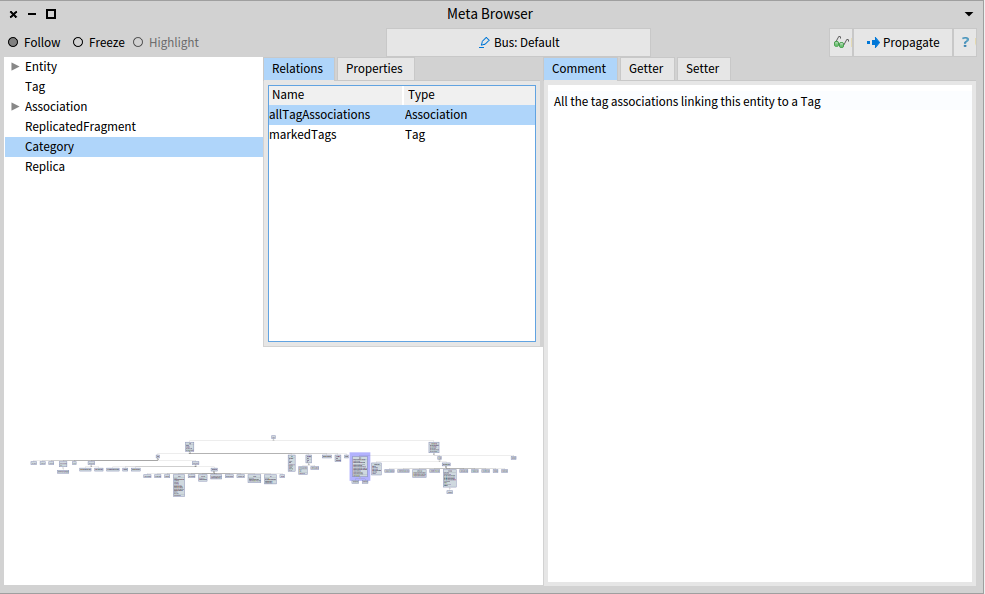
The browser shows the hierarchy of classes at the top-left. Selecting a class shows both the references to other classes and the primitive properties. At the bottom, a map of the overall class hierarchies is provided as a visualization. Furthermore, the comment of the current selection is shown to the right.
Developer tools
Moose Playground
The Moose Playground allows one to perform customized scripts. This browser is outside the Moose IDE environment. Thus you cannot benefit from the buses feature.
Be careful; when performing customized scripts, you can leave the Moose Environment. You may want to learn more Pharo before performing such a complex script
The Moose Playground with two additional feature compares to a classic playground: Inspect in Moose, and Models.
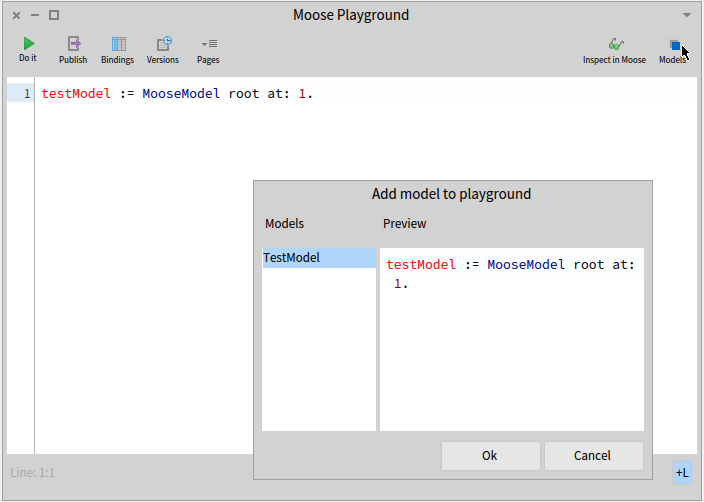
The Inspect in Moose button allows one to inspect an entity in a Moose Inspector. Thus, one can create a complex customized script and go back to the MooseIDE environment.
The Models feature allows one to get inside the Moose Playground a reference to a model loaded using Models Browser.
Thanks to the two features, one can connect custom scripts with the Moose environment.
